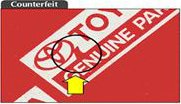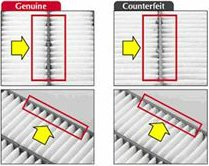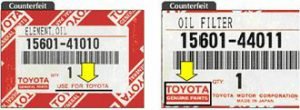At a first glance, the packaging may look like a Toyota Genuine Parts packaging, but when you look closely, you will see significant difference between the two. Here are some tips on how to determine if the part is genuine or not.
A. Logo is misspelled
Packages that bear a logo resembling the Toyota logo with different words or that includes the product name are obviously forged packages.

B. Printing quality is poor
Packaging quality should be consistent. Check the package color and printing quality. If the letters are distorted or the color of the package differs from that of the packages of other parts, it is a forged package. (However in some cases, the color of the package may change or it may become damaged according to the conditions in which it was stored.)

C. Size or typeface of logo differs from regulations
This was made with a font different from that of the Toyota logo. If you check the shape and thickness of the letters carefully, you will be able to tell the difference.
D. Content or part number label is wrong. Typeface logo is also wrong.
There are many cases in which a part can be distinguished by checking the part number label. If the letters are printed on the part number label improperly or the logo is created in a different font, it is a counterfeit.
E. 5% screen of Genuine Parts logo
Current logo of fiberboard package has a 5% screen on every other one. However, this 5% screen is only for products produced in Japan. “MADE IN JAPAN” is written on the part no. label. One that doesn’t have this 5% screen is a counterfeit package.
If by some chance, the packaging looks like that of a Toyota Genuine Part, do not be deceived. You may still have purchased a counterfeit part. This will help you determine some of the parts found in the market that are being sold as counterfeit products.
1. Oil Filter (Compact-Type)
A. The genuineness of a compact-type oil filter can be determined by the filter element or the way the filter paper folds.

There are two types of Genuine compact-type oil filters: the crystal type, which has a filter element folded into a distinctive shape, and the newly developed molded unit type. The element of each type has features that enable you to distinguish between counterfeit and genuine parts by looking at the element through the hole in the center of the bottom.
B. The compact-type oil filter made in Thailand can be identified by looking at the relief valve.

The compact-type oil filters made in Thailand feature newly developed filter paper made of high-efficiency fiber with a daisy-shaped element in which the folds radiate out from the center. These makes the new filters more difficult to distinguish from counterfeit which have radial folding pattern element.
1. Oil Filter (Compact-Type)
The conventional type of Genuine oil filter also uses the daisy-shaped element. It is difficult to determine genuineness by checking the element, so examine the outside to make a determination.
A. In many cases, counterfeit parts are not painted all the way to the lower rim of the outer shell.

B. The typeface of the TOYOTA logo on the counterfeit part is wrong, there are words that do not usually appear, such as “USE FOR JAPANESE CAR”


Distinguish the distributor contact point by the contact surface.

The contact surface of counterfeit parts doesn’t have a sheen, compared with that of Genuine Parts. Whether a part has a sheen or not enables distinction.


A. The TOYOTA logo, part number, and supplier name (DENSO) are not printed on the filter of many counterfeit parts.

B. The part where the filter paper and frame meet is crudely finished in counterfeit parts.

















